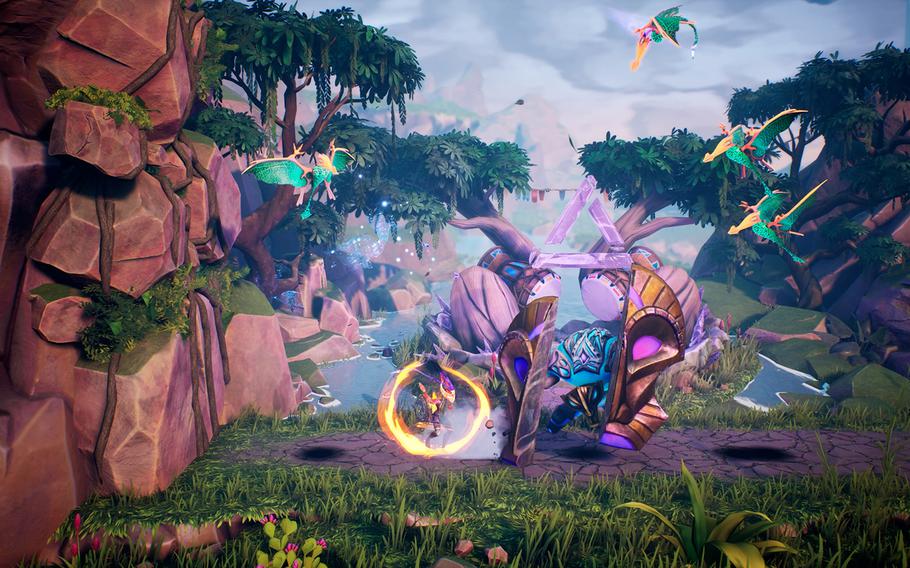
Zau is the protagonist in Tales of Kenzera: Zau. The Sun mask is focused on melee attacks while the Moon mask is ideal for ranged combat. (Electronic Arts/TNS)
When crafting Tales of Kenzera: Zau, Abubakar Salim thought of his father who passed away from cancer 10 years ago. The founder of Surgent Studios said his father believed that dead is dead, and that he didn’t want his son to spend time dwelling on his end.
That didn’t happen. Salim established a game studio, gathering a team of 30 to create a video game that’s a tribute to his father. Tales of Kenzera not only brings to life the Bantu culture of his father’s native Kenya, but it also carries part of Salim’s story. It’s about a boy named Keberi, who is mourning the death of his father. He searches through his late parent’s belongings and discovers a book he had written about Zau, a shaman of Amandla.
Making a deal
That’s the video game’s narrative frame as players mainly control Zau, who has made a deal with Kalunga, the god of death. If the young shaman can exorcise three great spirits who refuse to move on, then Kalunga would return his Baba back to Zau. That journey takes the young man through three realms that will test players’ combat and platforming skills in this Metroidvania-style adventure.
As Zau, players start off with the Sun and Moon masks. The Sun Mask specializes in powerful melee combat while the Moon Mask lets the protagonist attack from afar with projectiles. In combat, players need to switch between the two masks and use them strategically while dashing to avoid enemy attacks.
The masks have their own strengths and add powers over time. The Moon Mask can freeze foes so that players can switch to the more powerful Sun Mask to deal major damage. In other scenarios, players will have to match the mask to the color of foes’ Spirit Shields to break to defeat them. It may sound simple but when dealing with a several flying adversaries and shield-toting warriors, it becomes hectic.
Thankfully, combat does grow easier over time as players earn Ulogi soul energy from defeated foes and use those to earn Shaman Points. Players spend that resource on upgrades to Zau’s attacks to make them more powerful.

Zau picks up a power that lets him create temporary platforms in Tales of Kenzera: Zau. (Electronic Arts/TNS)
Platforming as tough as combat
The interplay between masks also extends to the platforming. For example, an acquired power lets Zau destroy barriers when he has the Sun Mask and rebuild temporary platforms with his Moon Mask. Players will have to switch and activate the masks while jumping around a level. Elsewhere, a fiery spear for the Sun Mask is needed to activate switches that open doors, but players will have to race to the opening before time runs out.
Similar to other Metroidvania titles, areas are gated and they can be accessed via assorted powers, but for Zau, they’re hidden away in the Shaman Shrines scattered around the world. Other abilities include a glide that lets him jump longer distances, a directional dash and the ability to lasso anchor points to zip to other areas. It takes a lot of time to master these moves because they’re so dependent on timing and positioning. At times, players will want to throw the controller or pull their hair out because of the learning curve.
Interestingly enough, the powers lend themselves to speedy traversal, and that flows into the challenge of Tales of Kenzera. The difficulty doesn’t come from puzzle-like rooms but rather it’s focused on how quickly players can navigate obstacles. The harder scenarios require quick reaction time and knowing the intricacies of such abilities as the cool-down time on a directional dash.

Tales of Kenzera: Zau has a handful of enemy types, and they all pose new challenges and patterns to learn. (Electronic Arts/TNS)
The details in the hidden power-ups
Players learn the finer details of these platforming and combat mechanics by tackling the challenges hidden in the world. Players will run across Shaman challenges that reward players with trinkets, which in turn offer stat tweaks and bonuses. Players can mix and match these to complement a playstyle. Meanwhile, challenge rooms reward players with the ability to equip more trinkets at once, but they have to go through trials where they must defeat waves of foes. Other places such as Reflection Points are easier to locate and offer the big bonus of more health.
Although Salim says Tales of Kenzera takes about eight to 10 hours to finish, the game may take longer for some. It has a handful of frustrating levels that punish players because of instant death spikes and brutal checkpoints that force players to do some sections repeatedly until they get it right. There’s a lot of trial and error, but that difficulty perhaps mirrors the struggle that Salim said he had with his father’s death.
The harder moments, including ones with dark clouds, convey the raw emotions and mood of that grieving process. Meanwhile, the stories and characters at the heart of the world’s three regions explore other aspects of loss through narrative. Unfortunately, the storytelling in these parts of Tales of Kenzera don’t always hit the right notes. The backstory behind the little girl Liyana and Impundulu, the great spirit of the sky, is touching but others such as the one aged warrior Bomani, who worries about the fate of his son, is more underdeveloped. It doesn’t quite connect.
That makes the journey a mixed bag, but at its core, Tales of Kenzera still has an emotional truth. It’s a game about grieving and accepting loss just as Salim ultimately did. Deeper than that though, the process allowed him to keep his father’s memory and culture alive and share it with bigger world.
Platform: PlayStation 5, Nintendo Switch, Xbox Series X and Series S, PC